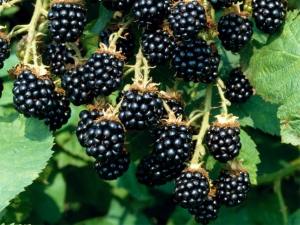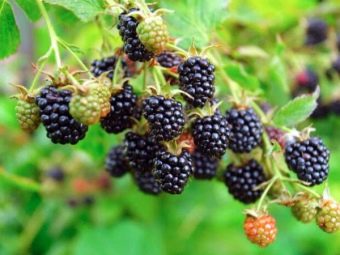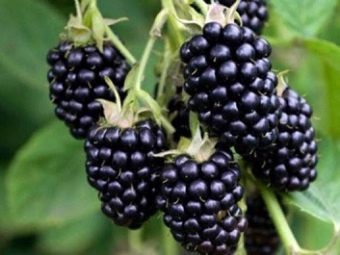Blackberry "Agavam": description of the variety, planting and care

Every year, breeders create dozens of new varieties of trees, shrubs and berry crops, but not every one of them becomes popular and settles for many years in the gardens of a particular area.Blackberries "Agavam" is a rather old variety, but still not lost its relevance, and therefore for proper cultivation it is important to know how to do it, what kind of care it needs and how to perform the planting. A variety of varieties allows you to extend the season of consumption of berries, taste and color palette.
Characteristic
Blackberries "Agavam" appeared a long time ago in America, where local varieties of wild blackberries were used for its breeding. In order not to be mistaken during the purchase of seedlings, you need to have an idea of what the plant looks like. Variety description is as follows:
- The dimensions of the bush are initially small, but in the process of development it can spread out over a long distance, where the length of one whip will be about three meters;
- the shoot has a pentahedral appearance, a large number of hook-shaped spines are located on it;
- the young shoot has a green color, the old one is brown;
- foliage grows from a single point and has a specific appearance: a rounded shape with a narrowed tip and a pubescent structure;
- Fruits are dark blue or black in color, medium size, slightly pubescent, located on the hand, where up to twenty berries ripen in different periods;
- the taste of berries is sweet and sour, the structure is dense, because they are easily transported over long distances;
- harvesting must be done on time, otherwise the fruits lose their taste and resemble grass.
Like any plant variety, the Agaveam blackberry has both advantages and disadvantages. Its positive side can be attributed to good resistance to frost, because it can be grown in regions with harsh winters. On the other hand, a variety grows poorly in excessively hot conditions, which is reflected in fruits that are often baked. The best conditions for it will be partial shade and moderate watering. If moisture is not enough, the berry will be fine and it may be less than with the required amount of water.
Another advantage of the Agave variety is soil undemanding: planting is possible on different soils, as long as they are nutritious, fairly light and moistened from time to time. The berries have a dense structure that allows them to be transported without loss of presentation. Of the inconveniences that all gardeners note, there are only thorns, which are quite numerous, with the result that harvesting can bring many problems and discomfort.
Planting such a crop in the garden, you can get stable yields for fifteen years without putting any significant effort into the process of growth and development of the bush. The variety has quite a lot of advantages, but there are almost no obvious flaws.
In addition to thorns, it is necessary to take into account the powerful root system, which spreads the blackberry all the further along the site. For the cultivation of varieties is a great opportunity to get planting material, and those who do not need a lot of bushes, will have to remove the cuttings from time to time.
How to plant?
Planting blackberries "Agawam" is no different from working with any other plant. So that everything goes well and the result has pleased many more years, you should adhere to such recommendations as:
- it is necessary to plant a bush only in spring so that the root system has time to take root and the blackberry has a good winter;
- in case of strongly acidic soils in the blackberry planting area, lime must be added to the soil;
- choosing a place for the future seedling, it is better to look for an open area, but in the case of hot regions you can arrange them in partial shade;
- preparing a pit for planting a seedling, you need to add a mullein, humus and superphosphate;
- only the planted shrub must be well cut, so that the shoots are no longer than 20–30 cm;
- pristvolny area should be mulched with sawdust or needles of coniferous trees;
- on the plot, the blackberry is located either in rows or by bushes in a free order, but so that each bush is given at least two meters for growth;
- Grade "Agave" needs a garter, because, laying the site for the crop, you need to provide for the rack and pull the wire on them.
The most favorable soil for blackberries is light sandy sand. After planting, it is imperative to water the shrubs well and tie them up until a large amount of spikes appear on the branches. In temperate climates, a blackberry planted in the sun produces more juicy and sweet fruits than the one that has been in the shade for some time.
How to care?
As well as planting, caring for blackberries "Agave" will not cause serious problems for the gardener. If you follow the basic rules, you can get consistently high yields of berries with minimal effort. The care process consists of:
- tying young shoots in autumn, before the onset of cold weather, preparing the bush for winter;
- full pruning of two-year bushes after harvest at the end of autumn, which allows the plant to easily winter and in spring to give a fresh and strong growth;
- watering blackberries with warm water, which is brought no more than once a week in an amount of 2–3 buckets depending on the weather;
- loosening the soil near the bush, which makes possible the penetration of oxygen into the soil for more productive growth of the plant;
- to protect against pests, it is best not to spray the bushes, but to plant a calendula near them, which will scare the May beetle and Medvedka, which threaten the health of the blackberry;
- before the beginning of the growing season it is worth feeding the plant with nitrogen fertilizer, and during the entire growth of the bush it will be necessary to add potassium supplements once.
The process of caring for blackberries "Agave" is not difficult, but, knowing some features, you can make it even simpler, but at the same time get large and healthy bushes, regularly giving good fruits. This culture is considered to be very resistant, because it can do for a long time without moisture and grow normally without a permanent sun, but the result of such conditions will not be the one that any gardener hopes for. The first wetting that a young bush receives after winter is melt water, which moisturizes the soil and triggers all the growth processes in the plant. The maximum attention to watering should be given to the berry during the ovary period, when the soil should not be allowed to dry out, as well as its excessive waterlogging.
Pruning is quite important in caring for blackberries, because the bush is vigorous. If no action is taken, the berries will begin to shrink, and the amount of the harvest will noticeably decrease, because the strength of the bush will be aimed at ensuring the vital activity of each of the branches. The first years pruning is practically not carried out, after planting and the formation of a bush, it is necessary to wait four years to form and strengthen the root system, and only after that can trimming works be carried out, which have their own goals. And this:
- removal of frozen and deformed twigs remaining after wintering;
- in the middle of summer, pruning of young shoots of about 10 cm is carried out in order to give an impetus to the growth of branches of the second order, which will give results as early as next year in the form of a bountiful and high-quality harvest;
- Shoots that have reached the age of two years must be completely removed.
The optimal number of branches, which should be on a bush, varies from four to six, additional shoots will not bring any benefit, but will only consume its energy. Since the branches can be about three meters in length, they are convenient and expedient to tie up. Having the opportunity, it is worthwhile to organize a garter at a height of 40, 120 and 170 cm. This option of caring for the vine will provide an opportunity not only to harvest the crop more quickly and with greater comfort, but also the plant will produce large yields with a large-sized berry.
For normal growth and fruiting of the blackberry from time to time it is necessary to feed the plant, for which various fertilizers are used. It is best to use organic additives: compost or humus.If the fertilizer was not carried out in time, then it is necessary to apply nitrogen fertilizers during the active growth of green mass. To add the necessary trace elements under the bush, you can use wood ash, which should be scattered around the bush. When watering or raining beneficial substances will gradually enter the soil, feeding it.
The final stage of caring for blackberries "Agave" is the proper preparation of the bush for the winter. Since the plant is not afraid of frost, there will not be any serious problems covering it for the winter. It is enough to thin the bush so that it is not thickened, to cut off two-year-old shoots, and young ones to bend down to the lowest wire and tie up.
If the shrub grows in a very cold region, it can be covered with burlap or cloth, lowered straight to the ground and fixed.
Diseases and pests
If the bush grows in the right conditions, with regular watering, pruning and all related activities, then the Agaves is not predisposed to any diseases. In case of any violations, a variety of problems can arise. If the soil is regularly overmoistened, then didimella and purple spotting may develop on the bush. Particularly favorable conditions for the spread of these fungal diseases in thickened plantings, where no pruning is done. Young shoots, stalks and buds are usually affected.
In some cases, it can be observed defeat gray mold, which is also provoked by fungi. Due to such an adverse effect, the whole plant is affected, but the result is especially clearly seen on the berries, which simply begin to rot, becoming covered with gray rot. To get rid of the manifestations of the disease, you need to use antifungal drugs. So that there is no danger of poisoning a person or bees that sit on flowering bushes, the spraying procedure is carried out before or after flowering. If the bushes continue to hurt often, it is recommended to transplant them to a new place, and onion, garlic or spices should be planted in the problem area.
If we talk about pests, then most often it is a weevil. If you carry out regular pruning and cleaning of old parts of the bush and leaves, then problems with pests should not be. If they do arise, there are specialized tools that will help to quickly and effectively get rid of them.
Reviews
Anyone who has ever tried to plant a blackberry "Agavam" on his plot has a definite opinion about this culture. Most agree that this is a good option for those who do not like to spend a lot of time on the site, digging under each tree and each bush. The main advantage is frost resistance, which is why in most of the territories the plants do not hide at all for the winter, which is very convenient if there is no time to prepare all the green areas for wintering.
Concerning the taste of berries, opinions are divided: someone is in complete delight from them and eats the whole family with a big appetite, but there are also those who talk about the tastelessness of fruits and more refined counterparts. Almost all are similar in that a significant lack of shrubs are thorns, because of which it is difficult to make all the manipulations with the plant: to plant, cut and even harvest. Those gardeners who have small children who regularly fall into the predatory claws of this shrub especially complain about the plant.
Almost all gardeners confirm that Blackberry "Agavam" is a useful berry, which is definitely worth growing, but most of all this option is suitable for novice gardenershard to work with whimsical cultures.
The undoubted advantage of the blackberry of this variety, as noted by almost all gardeners, is the yield of the plant, which, even without proper care, produces quite a lot of fruit. Of the minuses, some emit large dimensions of the bushes, because of which not every site has the ability to accommodate such a plantation.
In general, the reviews on the blackberry “Agavam” are positive, despite the fact that it has existed for a very long time and many have tried to plant it in the country or in the garden. Like any other plant, it has positive and negative sides, therefore, before rejecting the idea of planting this shrub, you should try it at least once, leave your opinion and, if necessary, write a corresponding review that will help other less experienced gardeners with a choice crops that are worth planting on the site.
In the next video you will find a review of the first harvest of blackberries "Agave".



































